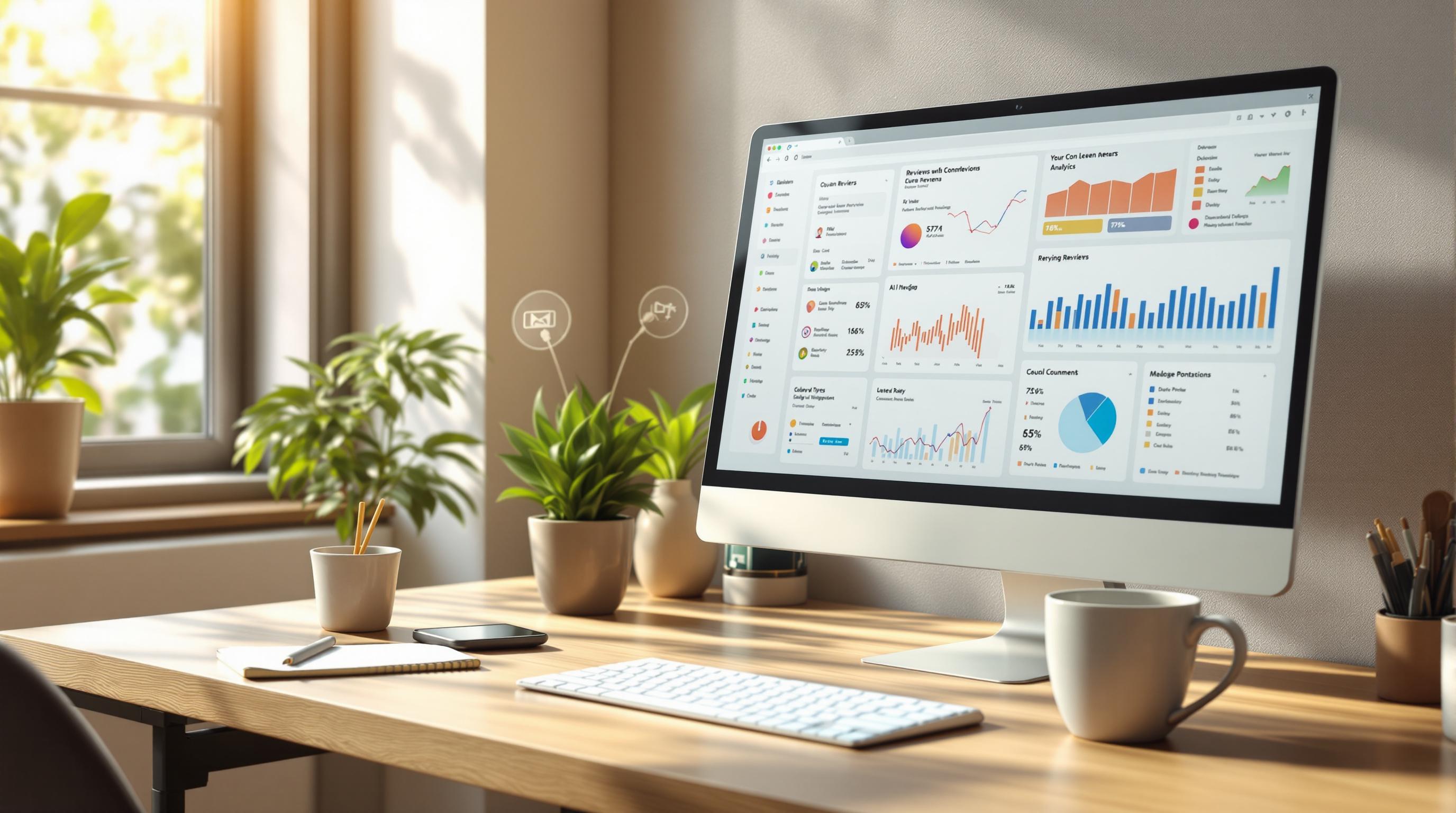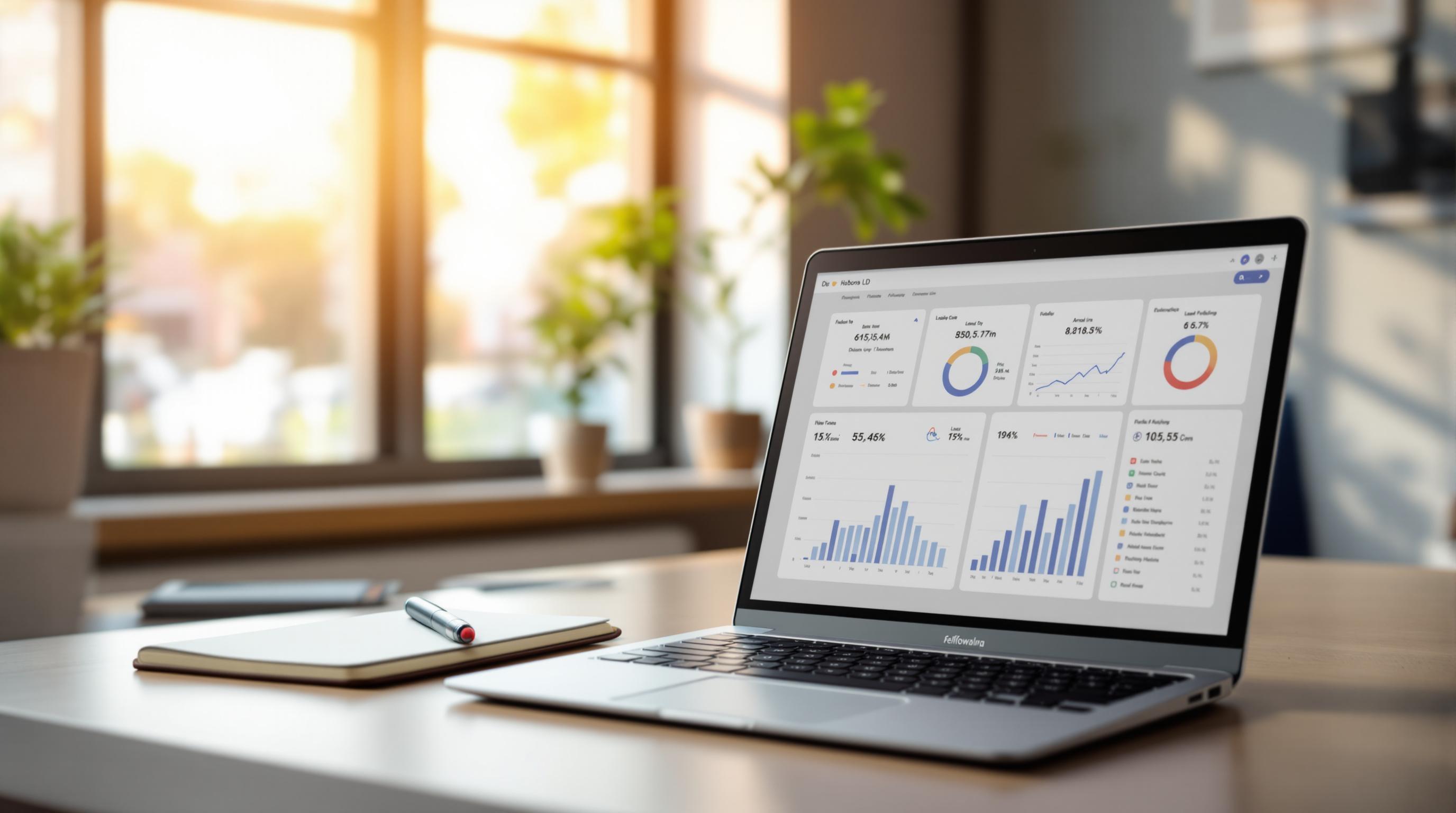WhatsApp Business automation is a powerful tool for converting leads, thanks to its 98% message open rate and 40% response rate within 5 minutes. With tools like chatbots, quick replies, and CRM integration, businesses can respond instantly, qualify leads, and streamline follow-ups. Whether you're a small business using the free app or scaling with the WhatsApp Business API, automation improves response times, boosts engagement, and increases conversion rates by up to 30%.
Key Takeaways:
- Chatbots: Automate lead qualification 24/7.
- Quick Replies: Save time with pre-written answers.
- CRM Integration: Sync WhatsApp with tools like Zapier to simplify workflows.
- Rich Media: Boost engagement by 300% using images, videos, and infographics.
| Feature | WhatsApp Business App | WhatsApp Business API |
|---|---|---|
| Message Volume | Limited | Up to 1,000/day |
| Device Support | Up to 4 devices | Unlimited |
| Integration Options | Basic | Full CRM integration |
| Cost | Free | Usage-based pricing |
| Analytics | Basic metrics | Advanced reporting |
Start automating today to improve response times, personalize follow-ups, and track performance for better lead conversions.
AI Lead Generation WhatsApp Chatbot For Any Business with ChatGPT Automation
Getting Started with WhatsApp Business Automation

When scaling your operations with WhatsApp, picking the right platform version is a key decision. It sets the foundation for how far you can take your automation efforts.
WhatsApp Business API vs. Standard App
Your choice between the WhatsApp Business API and the standard app will shape your automation potential. The API is built for businesses aiming to scale, while the standard app is better suited for smaller setups.
| Feature | WhatsApp Business App | WhatsApp Business API |
|---|---|---|
| Message Volume | Limited | Up to 1,000 unique customers/24h [2] |
| Device Support | Up to 4 devices | Unlimited |
| Integration Options | Basic | Full CRM/tool integration |
| Cost | Free | Usage-based pricing |
| Analytics | Basic metrics | Advanced reporting |
Connecting WhatsApp to Your Business Tools
Integrating WhatsApp with your existing tools is a smart way to streamline processes. Many businesses start by linking WhatsApp to their CRM systems. For instance, Phostra-Engine AI-LeadFlow's WhatsApp DBR Android feature can help automate lead collection and routing.
Here are some key integration steps:
- CRM Integration: Use tools like Zapier to connect the WhatsApp API to your CRM. This allows you to automatically create lead records and send sales notifications.
- Workflow Automation: Set up tools like Zapier to handle repetitive tasks. For example, when a lead messages your WhatsApp account, Zapier can create CRM entries, add leads to email lists, notify your team, and even schedule follow-ups.
Once these connections are in place, you can shift your focus to implementing automation that drives better conversions.
Must-Have Automation Features
To boost lead conversions, consider adding these key automation tools:
- Lead Qualification Chatbots: Automate conversations to filter leads based on predefined criteria.
- Quick Reply Templates: Save time with pre-written responses for common questions.
- Document Handling: Set up systems to automate the collection and organization of documents.
- Appointment Scheduling: Use automated booking tools to simplify scheduling.
These features can help you save time, stay organized, and convert leads more effectively.
Creating Lead Conversion Automation Systems
Leverage WhatsApp Business features to build systems that streamline lead conversions and work seamlessly together.
Setting Up a Lead Qualification Chatbot
Design your chatbot process in four key stages:
- Welcome: Start with a personalized greeting to engage users.
- Qualification: Ask 3–5 essential questions, such as budget or timeline, to gather relevant details.
- Scoring: Evaluate responses using a point-based system (assign 1–10 points per answer).
- Routing: Send leads to the sales team or place them in nurturing sequences based on their score.
For smoother operations, connect your chatbot to CRM tools using platforms like Zapier or N8N to automate lead routing.
Crafting Message Templates for Quick Responses
To create message templates that convert, focus on blending automation with a human touch. Businesses using personalized WhatsApp templates have seen conversion rates jump by 40% [6].
What makes a great template?
- Use dynamic fields to personalize (e.g., name, past interactions, product interest).
- Highlight a clear value proposition.
- Include a specific call-to-action to guide the recipient.
- Maintain a conversational, approachable tone.
Adding Media Content to Messages
Incorporating media into WhatsApp messages can dramatically improve engagement - by as much as 300% [8]. This increased interaction often leads to more conversions.
What works well for media?
- Short product demo videos (30–60 seconds)
- Infographics that clearly outline service benefits
- Customer testimonials in video or image format
Rich media isn’t just eye-catching - it’s a proven way to keep your audience engaged and drive results.
sbb-itb-4087e62
Measuring Automation Results
To get the most out of automation, focus on tracking these key metrics and setting up effective monitoring systems.
Key WhatsApp Metrics to Track
Businesses using WhatsApp automation report a 225% increase in response rates and 40% faster resolutions[1]. Keep an eye on these metrics to gauge success:
- Message Delivery Rate: Percentage of messages successfully delivered to recipients.
- Response Time: Average time it takes to reply to leads.
- Conversion Rate: The number of leads completing desired actions.
- Engagement Rate: How often users interact with your messages.
- Click-Through Rate: Frequency of clicks on links included in messages.
- Opt-out Rate: Percentage of users unsubscribing from your messages.
These metrics provide a clear picture of how tools like chatbots and message templates are influencing your outcomes.
Steps for Performance Tracking
Follow these strategies to ensure you're monitoring the right data:
- Use tools like WATI to track delivery rates and response times[2].
- Add UTM parameters to your message links to track campaign performance.
- Build custom dashboards in platforms like Google Data Studio or Tableau.
Integrating tools that map the entire customer journey - from first contact to conversion - is crucial. Experiment with A/B testing to compare different message formats and workflows, helping you identify what works best. Cross-reference this data with lead routing workflows to uncover actionable insights.
Evaluating WhatsApp's Impact
When assessing WhatsApp's effectiveness compared to other channels, consider these factors:
- Cost-per-Conversion: Measure how much you're spending to gain a customer across platforms.
- Customer Lifetime Value: Compare the long-term value of customers acquired through WhatsApp versus other channels.
- Response and Engagement Rates: Analyze patterns to see how users interact with your messages.
- Conversion Speed: Compare how quickly WhatsApp leads convert compared to other channels.
Research by MessageBird highlights WhatsApp's ability to excel in customer reach and engagement[7]. Use this data to confirm WhatsApp's role in your automation and lead conversion strategies.
For deeper insights, analyze weekly trends to see how message timing impacts conversion rates. Multi-channel tools like Twilio Segment can help you create unified reports, making it easier to showcase WhatsApp's contribution to your overall funnel.
Advanced Automation and Legal Requirements
Balancing advanced automation with regulatory compliance is crucial. According to recent data, 71% of consumers expect personalized interactions from businesses, making automation tools more important than ever[2]. These technologies go beyond basic performance tracking, helping businesses fine-tune their processes while staying within legal boundaries.
AI Tools for Message Personalization
AI-powered tools make it possible to deliver personalized messages on a large scale. For example, Phostra-Engine's WhatsApp DBR Android provides several advanced features:
- Dynamic templates that adjust based on user behavior
- Automated lead segmentation for targeted outreach
- Real-time A/B testing to optimize messaging
- Performance dashboards for instant insights
A great example of this in action: Kotak Mahindra Bank used a WhatsApp chatbot to cut loan approval times from 7 days to just 3 hours, while boosting applications by 40%[5].
Automating Document Collection
Automating document collection through WhatsApp simplifies the lead conversion process by removing unnecessary friction. Here's how automation improves each stage:
| Process Stage | Automation Feature | Conversion Impact |
|---|---|---|
| Initial Request | AI Chatbot Guidance | Speeds up the sales cycle |
| Document Upload | Secure File Transfer | Lowers the risk of drop-offs |
| Verification | Automated Checks | Shortens the qualification timeline |
| Storage | CRM Integration | Enhances lead tracking and follow-up |
Staying Within Messaging Rules
When using WhatsApp for automation, it's essential to follow its policies to maintain access to the platform. Key rules include:
- Explicit Opt-in: Users must actively agree to receive messages.
- 24-Hour Service Window: Free-form messages are allowed only within 24 hours of user interaction.
- Template Approval: All automated message templates must be verified by WhatsApp.
- Quality Rating: High engagement rates are necessary to avoid penalties or restrictions.
To stay compliant with GDPR and CCPA, use encrypted storage and conduct quarterly security reviews. Only collect the information you need, ensuring your workflows align with privacy regulations.
Conclusion: Improving Lead Conversion with Automation
By setting up essential metrics and automation workflows, WhatsApp proves to be a game-changer for lead conversion.
Key Takeaways
WhatsApp automation boosts customer satisfaction by 70% [2], thanks to its integration with CRM systems and AI-driven lead qualification.
The success of this approach hinges on three core elements:
- Integrated Systems: These include real-time lead tracking, performance monitoring, and automated workflows that ensure seamless operations.
- Automated Lead Qualification: AI ensures consistent lead evaluation, speeds up processing, and allows sales teams to focus on the most promising opportunities.
| Automation Component | Effect on Lead Conversion |
|---|---|
| Chatbots | Improves qualification efficiency by 40% |
| Quick Replies | Cuts response times by 62% |
| Analytics Tools | Enables real-time tracking of performance |
Next Steps for Automation
With 75% of B2B sales teams expected to use AI-driven tools by 2026 [4], staying ahead means focusing on these upgrades:
- Use chatbots capable of understanding context for better conversations.
- Pair quick-reply automation with human oversight, as discussed in the Message Templates section.
- Invest in top-tier analytics tools to refine lead scoring.
- Ensure compliance with WhatsApp's template approval policies to avoid disruptions.
FAQs
How to track WhatsApp leads?
You can track WhatsApp leads using a combination of campaign tagging, CRM syncing, and automation tools.
Campaign-Specific Tracking
Use unique, trackable links or QR codes for each campaign to monitor lead sources and engagement effectively [2].
CRM Integration
Connect your WhatsApp interactions with a CRM system. This allows automatic updates to lead records and scoring based on their level of engagement [2][3].
Automation Techniques
- Automatically tag leads based on their interaction patterns [9].
- Use real-time dashboards to monitor engagement as it happens.
- Score leads using specific criteria from chatbot interactions, as described in the Chatbot Setup section.
These methods work together to create a seamless system for tracking and managing WhatsApp leads.


